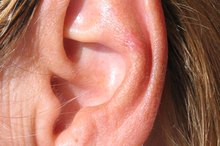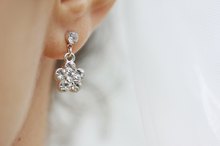What does fact checked mean?
At Healthfully, we strive to deliver objective content that is accurate and up-to-date. Our team periodically reviews articles in order to ensure content quality. The sources cited below consist of evidence from peer-reviewed journals, prominent medical organizations, academic associations, and government data.
- Medline: Perichondritis
- BMJ: April 2001: “High” ear piercing and the rising incidence of perichondritis of the pinna
- BMJ: April 2001: “High” ear piercing and the rising incidence of perichondritis of the pinna
The information contained on this site is for informational purposes only, and should not be used as a substitute for the advice of a professional health care provider. Please check with the appropriate physician regarding health questions and concerns. Although we strive to deliver accurate and up-to-date information, no guarantee to that effect is made.
Health Risks Associated With Cartilage Ear Piercings
Piercing the higher portion of the ear, known as the cartilage, is a fashion statement that can be dangerous. Before deciding to pierce the upper portion of your ear, familiarize yourself with the health risks associated with cartilage ear piercings. And if you decide to proceed, you will be able to quickly recognize the signs of a complication and get treatment promptly.
Perichondritis
Perichondritis, an infection of the upper ear, is mostly caused by piercing the cartilage, according to MedlinePlus 1. It is diagnosed by a redness around the site of the piercing. In severe cases, puss may secrete from the hole, and a severe infection of the ear called chondritis may occur that can damage the ear's structure. MedlinePlus also notes that the way to avoid perichondritis is not to pierce ear cartilage, and that the only treatment is antibiotics 1.
Excessive Bleeding
How to Treat an infected ear piercing
Learn More
After the initial piercing, cartilage may bleed more. Cartilage is much more susceptible to damage than the lobe, and the resulting bleeding doesn't seem to clot well.
Keloids
Keloids are large, puffy scars that may form when the skin is too thin and scars rather than healing. Especially after a bad infection, keloids can appear on the top portion of the ear as a result of piercing, notes the American Academy of Family Physicians 2. Cortisone injections, pressure dressing and laser therapy can help smooth out the skin, but it can leave the ear scarred after cartilage piercing.
Pseudomonas
Ear Cartilage Infection Symptoms
Learn More
Pseudomonas is a type of bacterial infection common in cartilage ear-piercing, according to a study performed by the Ear, Nose, and Throat Department, University Hospital of Wales, and published in 2001 in the British Medical Journal. Pseudomonas can result in widespread infection, fever and deformity of the ear, or "cauliflower ear" as it is sometimes referred to. Usually the cause of chondritis, pseudomonas bacteria attacks the site of the piercing, rendering it sore, red and enlarged. Pseudomonas is generally resistant to antibiotics, and most often someone suffering from a severe chondritis infection is admitted to the hospital for intravenous medications.
- Pseudomonas is a type of bacterial infection common in cartilage ear-piercing, according to a study performed by the Ear, Nose, and Throat Department, University Hospital of Wales, and published in 2001 in the British Medical Journal.
- Usually the cause of chondritis, pseudomonas bacteria attacks the site of the piercing, rendering it sore, red and enlarged.
Related Articles
References
- Medline: Perichondritis
- American Academy of Family Physicians: Complications of Body Piercing
- American Academy of Dermatology: Tattoos, Body Piercings, and Other Skin Adornments
- BMJ: April 2001: “High” ear piercing and the rising incidence of perichondritis of the pinna
- UpToDate. Diagnosis and management of foreign bodies of the outer ear. Updated January 13, 2017.
- Merck Manual. Perichondritis. August 2019.
- Merck Manual. Relapsing polychondritis. April 2018.
- Yahalom S, Eliashar R. Perichondritis: a complication of piercing auricular cartilage. Postgrad Med J. 2003;79(927):29. doi:10.1136/pmj.79.927.29
- Borgia F, Giuffrida R, Guarneri F, Cannavò SP. Relapsing polychondritis: an updated review. Biomedicines. 2018;6(3). doi:10.3390/biomedicines6030084
- Brant, JA, Ruckenstein, MJ. Cummings Otolaryngology: Infections of the External Ear. 6th ed. 2015;137:2115-2122.e2.
- Diagnosis and management of foreign bodies of the outer ear. Updated January 13, 2017.
Writer Bio
Kay Ireland specializes in health, fitness and lifestyle topics. She is a support worker in the neonatal intensive care and antepartum units of her local hospital and recently became a certified group fitness instructor.









